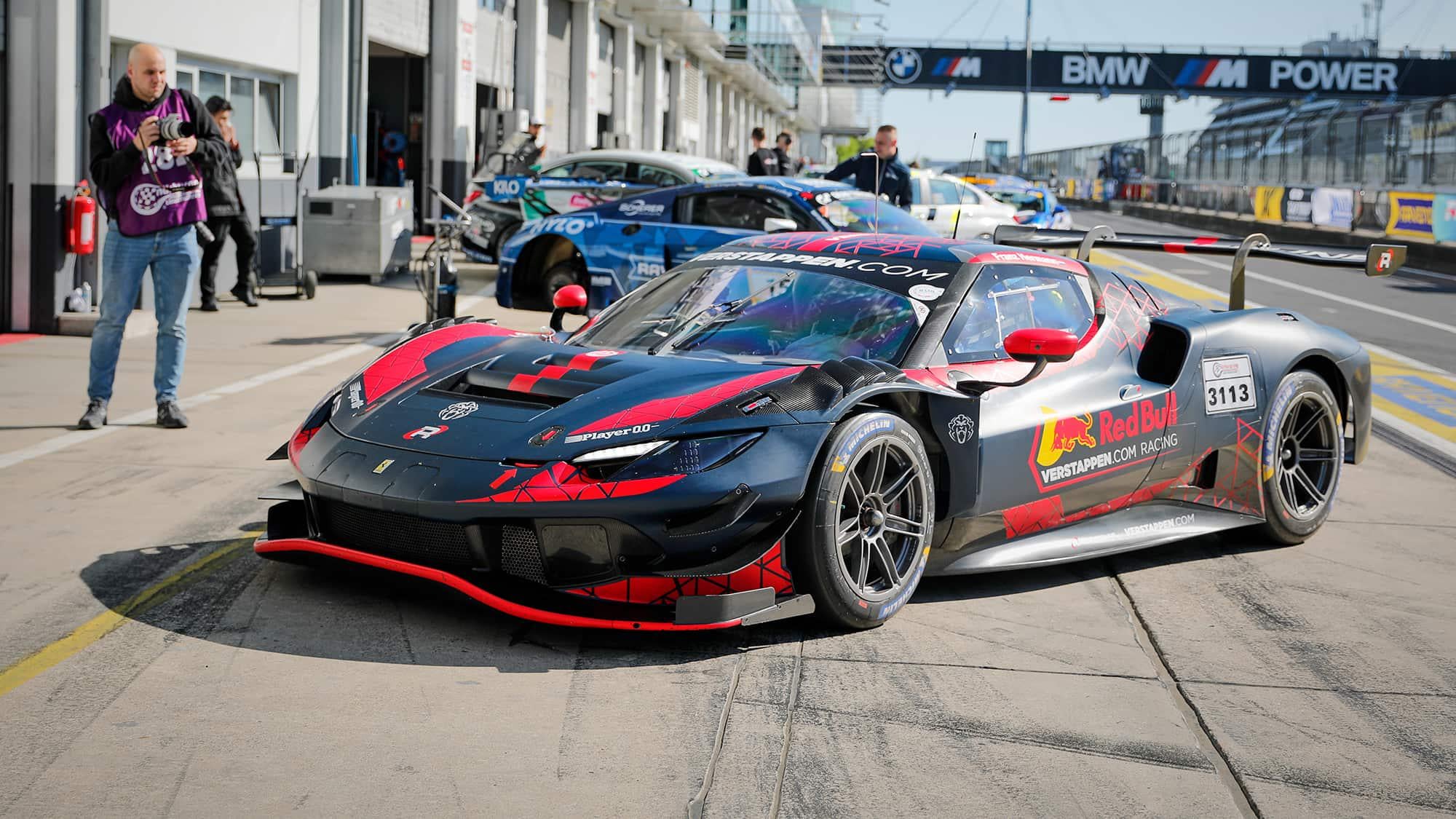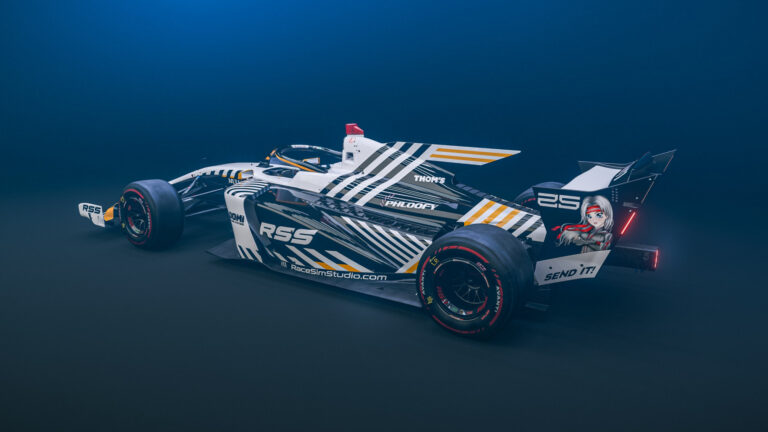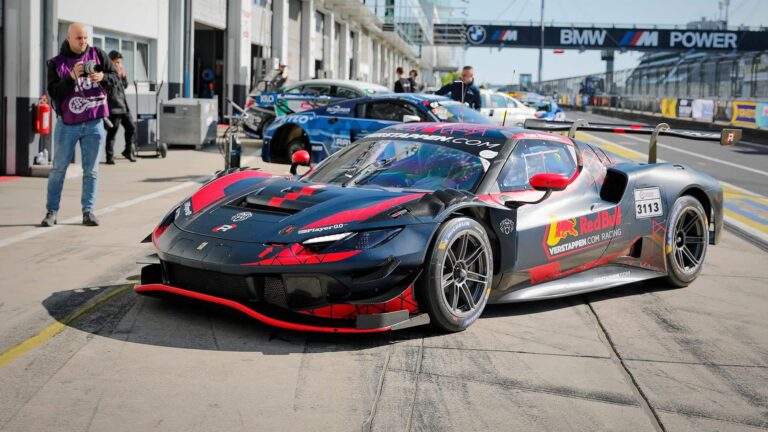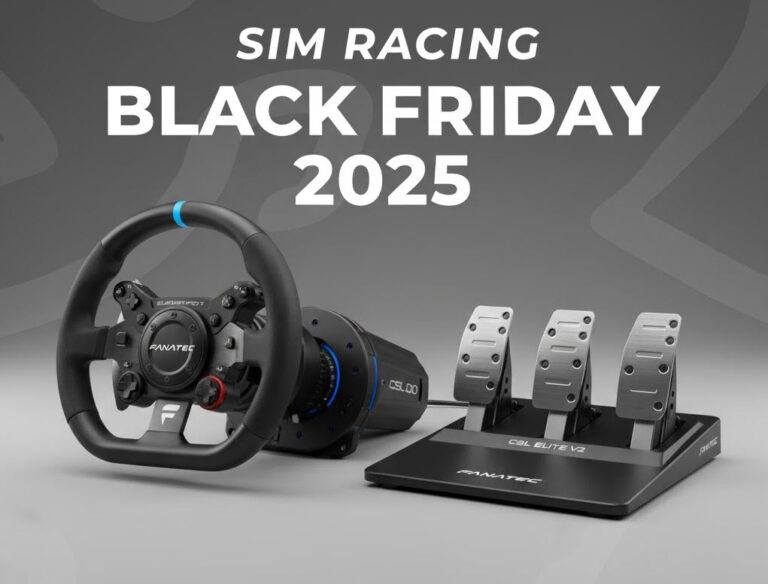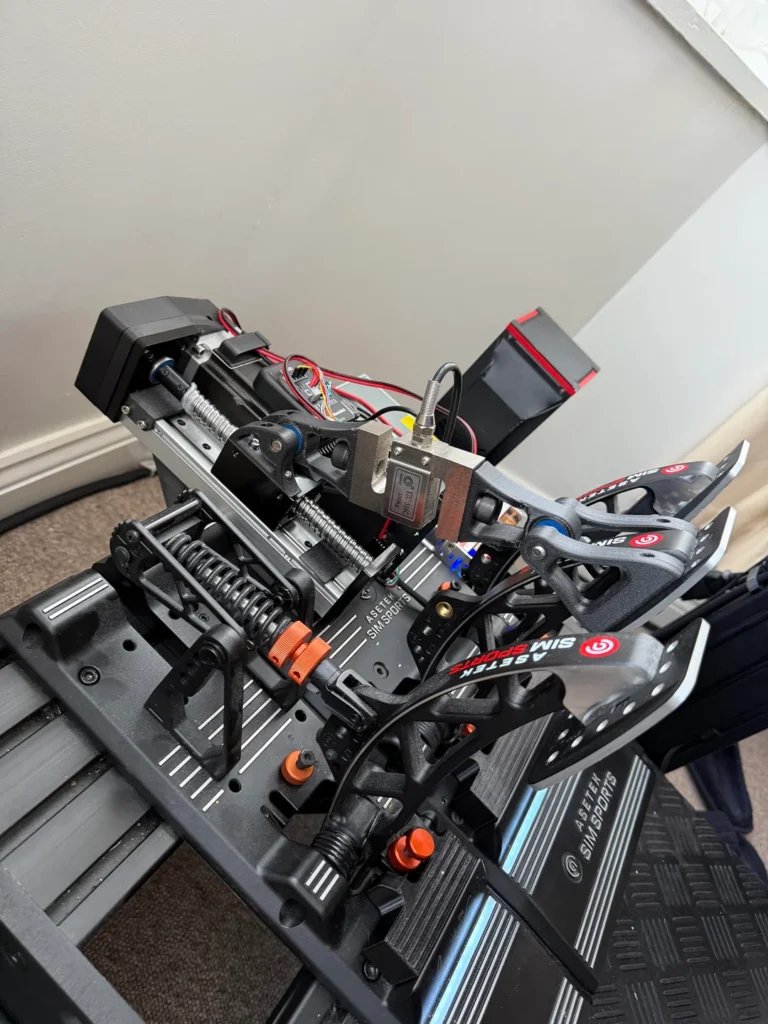Featured Image: Max Verstappen competing at NLS9 in the Emil Frey Ferrari 296 GT3
Germany’s motorsport federation has just made what I’d consider one of the most significant decisions in sim racing history. For the first time in international motorsport, virtual racing now officially counts towards obtaining a real-world racing licence – specifically, the DMSB Permit Nordschleife (DPN) Level B.
Having spent countless hours myself learning the Nordschleife in iRacing and Assetto Corsa Competizione, I know firsthand just how demanding this circuit is. The fact that German motorsport authorities now recognise sim racing as legitimate preparation for tackling the Green Hell in reality isn’t just symbolic – it’s a practical acknowledgement of how far sim racing has come.
What’s Changed?
The DMSB has introduced three routes to obtaining the DPN Level B permit, with the third option being entirely new:
- Complete the standard DPN B course (as Max Verstappen did before his NLS7 start)
- Complete two RCN races with a driver change, or one as a solo driver
- New: One RCN race with a driver change, combined with finishing three penalty-free Digital Nurburgring Langstrecken-Serie (DNLS) races
The key detail here is “penalty-free” – you can’t just participate, you need to demonstrate clean, competent racing across three of the four DNLS winter championship rounds. This isn’t a shortcut; it’s a recognition that proper sim racing develops real skills.

They’ve also eased the requirements for Permit A (which allows you to compete in faster cars, including GT3). Instead of two results and 14 race laps, you now need just one result and eight laps in a Permit-B car. The minimum driving time criterion of 20% total race time has been removed entirely.
The Verstappen Effect
This decision wasn’t made in a vacuum. Max Verstappen’s performance at NLS9 in September 2025, driving the Emil Frey Ferrari 296 GT3, demonstrated something the sim racing community has known for years but struggled to prove to traditional motorsport: virtual racing builds genuine racecraft.
Verstappen had no real-world experience in multi-class racing before that event. Yet his performance in traffic was exceptional, and his secret was extensive iRacing practice at the Nordschleife, including DNLS participation. VLN sporting director Christian Vormann put it perfectly: “It was no surprise that he immediately felt comfortable.”
What’s particularly impressive is that Vormann himself works in both real NLS race control and DNLS race direction, so he’s uniquely positioned to judge the crossover between virtual and reality. His statement that sim racing “reproduces reality in a highly accurate way” carries weight precisely because he sees both sides.
Why the Nordschleife Specifically
The Nordschleife isn’t just any circuit. At over 25 kilometres with more than 170 corners, it’s genuinely dangerous if you don’t know what you’re doing. The DPN system exists precisely because the consequences of incompetence at the Nordschleife can be catastrophic – both for drivers and for the circuit’s ability to continue hosting events.
The old requirements sometimes left drivers in what insiders called a “waiting loop” – you needed track time to get the permit, but couldn’t get meaningful track time without the permit. Even Valentino Rossi has complained about this, telling Motorsport.com that he wants to race the Nurburgring 24 Hours “when the circumstances are right” but struggles to find time to meet the permit requirements.
By allowing DNLS participation to partially fulfil requirements, the DMSB has created a more accessible pathway whilst still ensuring competence. You’re still racing the same circuit with the same challenges – just virtually first.
What This Means for Sim Racers
If you’re a competent iRacing or ACC driver who’s been considering real-world racing at the Nordschleife, this changes your pathway significantly. The DNLS runs during winter (when real-world NLS is suspended), so you can now build towards your permit during the off-season.
The caveat is that you still need one real RCN race with a driver change, so this isn’t a purely virtual route. But it reduces the barrier substantially. Instead of needing two full RCN weekends, you need one RCN race plus three clean DNLS performances, something you can prepare for entirely from your sim rig.
It’s worth noting that this only applies to Permit B (the entry-level Nordschleife licence). Drivers holding a National A licence still need three classified RCN races. This seems sensible. If you’re already competing at a high level nationally, you should demonstrate that competence in the real-world feeder series.
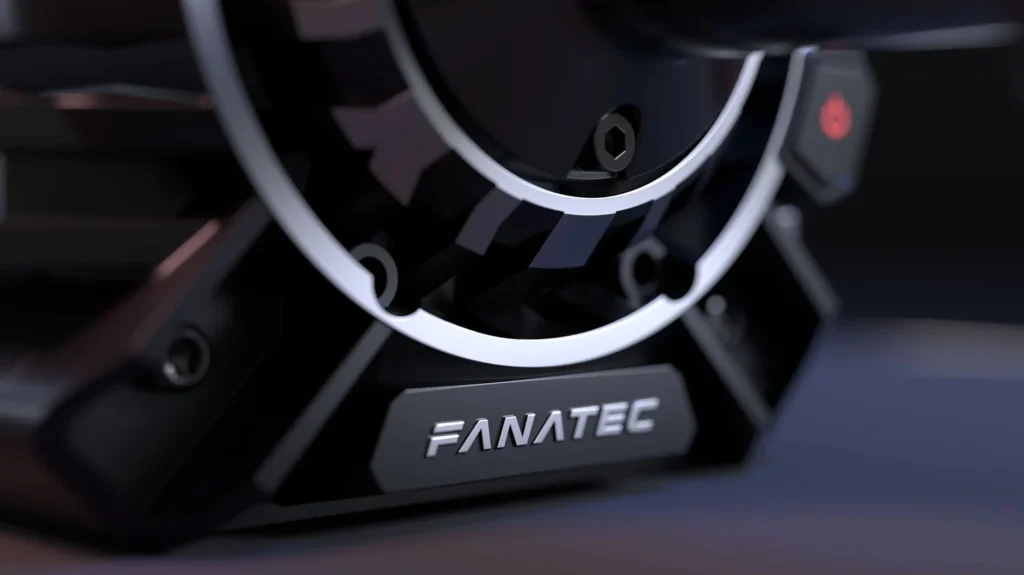
The Bigger Picture
Germany’s ASN (Automotive Sport National authority) has been ahead of the curve on sim racing for years. Back in October 2018, they officially recognised sim racing as a motorsport discipline. This latest move takes that recognition from symbolic to practical.
Robin Strycek, DMSB coordinator for sport, highlighted the unique ecosystem that makes this possible: “Alongside the NLS organisation, Porsche is represented through the PEETN, and marshals and officials from real-world NLS and the motorsport scene are active participants.”
This matters because it addresses the fundamental question about sim racing: does it actually teach real skills, or is it just entertainment that happens to look like racing? The DMSB’s answer, backed by Verstappen’s performance and years of DNLS operation, is clear: it teaches real skills.
The FIA will be watching this closely. As the article from Motorsport.com notes, allowing sim racing to count toward licence qualification is unprecedented in international motorsport. If the DMSB’s approach proves successful (and early indications from Verstappen suggest it will), other national authorities may follow.
How This Compares to Traditional Racing Licences
To understand just how significant this change is, it’s worth looking at the traditional pathways to competition licences in motorsport. The costs and timelines involved make the DMSB’s sim racing recognition genuinely revolutionary.
The Formula Ladder: How much does it cost?
The traditional route to professional motorsport is eye-wateringly expensive. Getting from karting to Formula 1 typically costs between £8-12 million over 10-15 years. Break that down by category:
- Karting (7 years): £300,000-£400,000 total. This is where almost everyone starts, often from age 5-8.
- Formula 4: £150,000-£250,000 per season. Entry-level single-seaters.
- Formula 3: £800,000-£1.2 million per season. This is where serious backing becomes essential.
- Formula 2: £2-3 million per season. The final step before F1, with only the best progressing.
- FIA Super Licence: €11,453 base fee, plus €2,313 per championship point from the previous season. Max Verstappen’s 2025 Super Licence cost over €1 million.
That’s before you factor in testing, spare parts, travel, coaching, or the reality that you need to be competitive, not just participating to progress. A mid-pack F4 season won’t get you noticed. You need podiums, which means front-running teams, which means even more money.
GT3 Racing: A More Accessible Alternative
GT3 racing offers a different pathway, particularly for “gentleman drivers” who start later in life. For major GT3 series like SRO GT World Challenge or IMSA, you need an FIA International Grade C licence as a minimum. The costs are substantial but more achievable:
- GT3 Car: £530,000-£750,000 to purchase new (Ferrari 296 GT3 at the top end, BMW M4 GT3 around £530,000).
- Season Running Costs: £800,000-£1.2 million for a full GT World Challenge campaign, covering entry fees, team support, tyres, fuel, and logistics.
- Single Race Weekend: £30,000-£40,000 including tyres, mechanics, data engineer, and entry fees.
The advantage of GT3 is that you can start later – your age doesn’t matter as much as your budget and competence. The FIA’s Bronze/Silver/Gold/Platinum driver categorisation system ensures competitive balance in Pro-Am classes.
The Nordschleife Permit: Cost Comparison
This is where the DMSB’s decision becomes truly interesting. The traditional route to a DPN Permit A (required for GT3 at the Nordschleife) used to involve:
- DMSB National A Licence: €599 for the course, €228 for the licence, €100 for medical check.
- Track Experience: 18 laps in VLN races over two events (previously). At €6,750-€8,500 per VLN race when sharing costs between three drivers, you’re looking at £13,500-£17,000 minimum.
- Total Traditional Route: Approximately £15,000-£20,000 to obtain the permit, plus whatever it costs to maintain competence.
The new route cuts this dramatically:
- One RCN Race: Around €2,800 (£2,400) for entry-level cars, including licence course and medical.
- Three DNLS Races: Your sim rig investment (if you don’t already have one) plus iRacing subscription and content. Let’s say £2,000-£3,000 for a decent rig if starting from scratch, or essentially free if you’re already sim racing.
- Total New Route: Approximately £2,400-£5,400 depending on your existing equipment.
That’s a reduction of roughly 70-85% in the financial barrier to entry. More importantly, the majority of your preparation can now happen at home, on your schedule, without the logistics nightmare of travelling to the Nürburgring multiple times.
Time Investment: The Hidden Cost
The Formula 1 pathway typically takes 10-15 years from starting karting at age 5-8 to making an F1 debut. Even talented drivers need multiple seasons in each category to develop skills and accumulate Super Licence points. Lewis Hamilton started karting at eight and debuted in F1 at 22 after 14 years of progression.
For GT3 racing, the timeline can be compressed if you have the budget. You could theoretically go from zero to DPN Permit B in under a year now:
- Winter (Nov-Feb): Complete three penalty-free DNLS races whilst learning the circuit.
- Spring/Summer: Take your DPN course and compete in one RCN race.
- Same Year: Obtain Permit B and start competing in NLS.
Compare that to the traditional route requiring multiple RCN weekends, scheduling around race calendars, and the inevitable delays from mechanical issues or weather. The sim racing route is not just cheaper – it’s dramatically more time-efficient.
My Take
This is genuinely brilliant. Not because it makes licensing easier – the requirements are still substantial, but because it recognises what many of us who race both virtually and in reality have known for years: modern sim racing, done properly, builds genuine racecraft.
The Nordschleife is the perfect circuit for this experiment. Its complexity and length make real-world practice expensive and limited. Virtual practice lets you learn the circuit thoroughly before risking your (or someone else’s) expensive machinery. The fact that Verstappen, one of the world’s best drivers, chose to prepare this way tells you everything you need to know about sim racing’s legitimacy.
What strikes me most about the cost comparison is how democratic this makes Nordschleife racing. Yes, you still need serious money to compete in NLS or the 24 Hours – a GT3 season isn’t cheap. But the barrier to entry has dropped from £15,000-£20,000 to under £5,000. That’s the difference between “financially impossible for most enthusiasts” and “achievable with serious saving and commitment.”
If you’re a serious sim racer, the DNLS just became significantly more important. Those winter championship rounds aren’t just fun racing anymore – they’re potentially your pathway to competing in one of the world’s most challenging real-world racing series.
Source: Motorsport.com
Related Articles
Sim Racer Builds Setup on CNC Machine: Wheelbase, Pedals, Shifter, and More
Max Verstappen Uses Assetto Corsa for F1 Race Preparation
MOZA Black Friday 2025: 29% Off Direct Drive Wheels & Bundles
Sim Racing Now Counts Towards Nordschleife Racing Licence
Sim Racing Black Friday Deals 2025
DIY Sim Racer Converts Asetek Invicta Brake to Active Pedal for £230
Topic: Sim Racing Beginners

